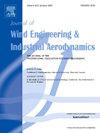极端风条件下影响中高层建筑玻璃幕墙损伤的特征识别
IF 4.9
2区 工程技术
Q1 ENGINEERING, CIVIL
Journal of Wind Engineering and Industrial Aerodynamics
Pub Date : 2025-09-17
DOI:10.1016/j.jweia.2025.106232
引用次数: 0
摘要
虽然极端风事件下玻璃幕墙性能的重要性已经引起了人们的注意,但需要进一步的研究来全面了解。几十年来,休斯顿中央商务区的中高层建筑反复出现玻璃幕墙损坏,这进一步强调了这一需求。本文的重点是识别在极端风事件中影响此类建筑物玻璃立面破坏的特征。首先,对1980年至2024年美国历史上的玻璃损坏进行了综合分析,重点关注可获取信息的案例。这些记录补充了文献和作者的观点,形成了三个特征类别:建筑、结构和环境。它们包括与设计和位置相关的特征,这些特征可能会导致风暴期间玻璃表面的损坏。通过涉及不同风暴类型的两个案例研究证明了它们的适用性:休斯顿德雷科(2024年)和劳拉飓风(2020年)。事件后建筑物损坏图像用于评估所提出的特征。结果表明,建筑和结构特征对于表征玻璃幕墙系统、推断缺失信息以及识别建筑形状和足迹中的潜在漏洞非常有用。环境特征有助于解释在人口密集的城市地区,周围建筑物的空间布局如何放大风荷载。本文章由计算机程序翻译,如有差异,请以英文原文为准。
Identification of features influencing glass façade damage in mid- to high-rise buildings during extreme wind events
While the importance of glass façade performance under extreme wind events has gained attention, further research is needed for a comprehensive understanding. Decades of recurring glass façade damage in mid- to high-rise buildings in Houston’s Central Business District further underscore this need. This paper focuses on identifying features that influence glass façade damage in such buildings during extreme wind events. Initially, a synthesis of historical glazing damage in the United States from 1980 to 2024 is conducted, focusing on cases with accessible information. These records are supplemented with literature and the authors’ opinions to develop three feature categories: architectural, structural, and environmental. They encompass design- and location-related features that may contribute to glass façade damage during windstorms. Their applicability is demonstrated through two case studies involving different windstorm types: the Houston Derecho (2024) and Hurricane Laura (2020). Post-event building damage imagery is used to evaluate the proposed features. Results show that architectural and structural features are useful for characterizing glass façade systems, inferring missing information, and identifying potential vulnerabilities in building shape and footprint. Environmental features help explain how the spatial arrangement of surrounding buildings may amplify wind loads in dense urban areas.
求助全文
通过发布文献求助,成功后即可免费获取论文全文。
去求助
来源期刊
CiteScore
8.90
自引率
22.90%
发文量
306
审稿时长
4.4 months
期刊介绍:
The objective of the journal is to provide a means for the publication and interchange of information, on an international basis, on all those aspects of wind engineering that are included in the activities of the International Association for Wind Engineering http://www.iawe.org/. These are: social and economic impact of wind effects; wind characteristics and structure, local wind environments, wind loads and structural response, diffusion, pollutant dispersion and matter transport, wind effects on building heat loss and ventilation, wind effects on transport systems, aerodynamic aspects of wind energy generation, and codification of wind effects.
Papers on these subjects describing full-scale measurements, wind-tunnel simulation studies, computational or theoretical methods are published, as well as papers dealing with the development of techniques and apparatus for wind engineering experiments.

 求助内容:
求助内容: 应助结果提醒方式:
应助结果提醒方式:


